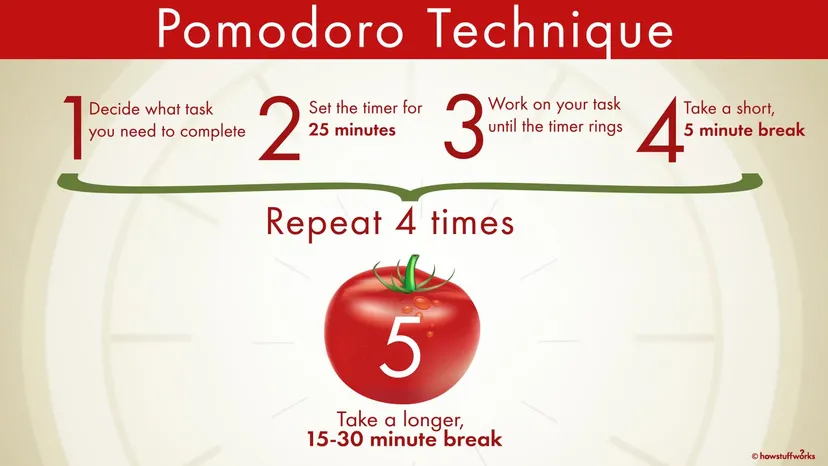The Pomodoro Technique is a time management method developed by Francesco Cirillo in the 1980s.
It uses a kitchen timer to break work into 25-minute intervals, typically 25 minutes in length.

Each interval is known as a Pomodoro, from the Italian word for tomato, after the tomato-shaped timer he used as a student.
By offering timers and instructions, apps and websites have greatly benefitted and also have increased the technique’s popularity.
The approach has been implemented in pair programming environments and is closely connected to ideas such as timeboxing and iterative and incremental development used in software design.
The original Method Of The Pomodoro Technique Have Six Steps:
- Decide the task to be done.
- Set a Pomodoro timer (typically for 25 minutes).
- Work on the task.
- When the timer goes off, end working and take a little rest (typically 5–10 minutes).
- If you have completed fewer than three pomodoros, return to Step 2 and continue the process until you have completed all three.
- Take the fourth Pomodoro after the first three have ended, followed by a lengthy pause (typically 20 to 30 minutes). Return to step 2 after the long rest.
A Pomodoro is indivisible; when one activity is interrupted during a Pomodoro, the other activity must be postponed or abandoned.
After task completion in a Pomodoro, any remaining time should be devoted to activities, for example:
- Review your work just completed.
- Review the activities from a learning point of view (ex: What learning objective did you accomplish? What learning outcome did you accomplish? Did you fulfill your learning target, objective, or outcome for the task?)
- Review the list of upcoming tasks for the next planned Pomodoro time blocks, and start reflecting on or updating them.
Cirillo suggests:
- Specific cases should be handled with common sense: If you finish a task while the Pomodoro is still ticking, the following rule applies: If a Pomodoro begins, it has to ring.
- It’s a good idea to take advantage of the opportunity for overlearning, using the remaining portion of the Pomodoro to review or repeat what you’ve done, make small improvements, and note what you’ve learned until the Pomodoro rings.
- After completing a task in a pomodoro, any remaining time should be devoted to reviewing the activities from a learning point of view.
- In the planning phase, tasks are prioritized by recording them in a “To Do Today” list.
- As pomodoros are completed, they are recorded, adding to a sense of accomplishment.
Pomodoro Tools
The physical act of winding the timer confirms the user’s determination to start the task; ticking externalizes the desire to complete the task.
Also, Read | Why We Grow Wisdom Teeth as Adults
The technique has inspired application software for many platforms, with several programs available.





